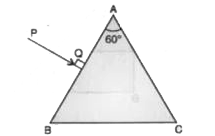A ray of light, incident on an equilateral glass prism μg=√3) moves parallel to the base line of the prims inside it. Find the angle of incidence for this ray. Solution in Kannada

From the diagram, r=30∘
Also n21=sinisinr
⇒√3=sinisin30
⇒sini=(√3×12
⇒i=60∘
Topper's Solved these Questions
- BOOK - OSWAAL PUBLICATIONCHAPTER - RAY OPTICS AND OPTICAL INSTRUMENTSEXERCISE - TOPIC-2(SHORT ANSWER TYPE QUESTIONS-II)1videos
RAY OPTICS AND OPTICAL INSTRUMENTS
- BOOK - OSWAAL PUBLICATIONCHAPTER - RAY OPTICS AND OPTICAL INSTRUMENTSEXERCISE - TOPIC-2(LONG ANSWER TYPE QUESTIONS)1videos
RAY OPTICS AND OPTICAL INSTRUMENTS
- BOOK - OSWAAL PUBLICATIONCHAPTER - RAY OPTICS AND OPTICAL INSTRUMENTSEXERCISE - TOPIC-2(VERY SHORT ANSWER TYPE QUESTIONS)4videos
RAY OPTICS AND OPTICAL INSTRUMENTS
- BOOK - OSWAAL PUBLICATIONCHAPTER - NUCLEIEXERCISE - TOPIC -2 (Numerical Problems)3videos
NUCLEI
- BOOK - OSWAAL PUBLICATIONCHAPTER - Sample Paper 1EXERCISE - Exercise36videos
Sample Paper 1
Similar Questions
A ray PQ is incident normally on the face AB of a triangular prism of refracting angle of 60∘, mae of a transparent material of refractive index √32, as shown in the figure. Trace the path of the ray as it passes through the prism. Also calculate the angle of emergence and angle of deviation.
 03:49View Solution
03:49View SolutionDerive the expression for refractive index of the material of the prism in terms of angle of the prism and angle of minimum deviation.
01:20View SolutionWhat is dispersion of light?
03:36View SolutionThe half life of 38Sr90 isotope is 28 years. What is the rate of disintegration of 15 mg of this isotope? (Given Avogadro No =6.023×1023)
05:18View SolutionCharges of 10μC and 15μC are separated by a certain distance. Which charge repels the other with a greater force?
05:14View SolutionWhat is the angle of incidence for an equilateral prism of refractive index sqrt(3) so that the ray si parallel to the base inside the prism?
01:05View SolutionA ray of light incident on an equilateral triangular glass prism of mu = sqrt(3) moves parallel to the base of the prism inside it. What is the angle of incidence for this ray ?
03:34View SolutionA ray of light undergoes deviation of 30∘ when incident on an equilateral prism of refractive index √2. The angle made by the ray inside the prism with the base of the prism is
View Solutionसमबाहु काँच प्रिज्म (μg=√3) पर आपतित होने वाले प्रकाश किरण प्रिज्म के अंदर उसके आधार के समांतर चलती है | इस किरण के लिए आपतन कोण ज्ञात कीजिए |
04:51View SolutionA ray of light incident on an equilateral glass prism propagates parallel to the base line of the prism inside it. Find the angle of incidence of this ray. Given refractive index of material of glass prism is √3.
02:27View SolutionFor an angle of incidence θ on an equilateral prism of refractive index √3 , the ray refracted is parallel to the base inside the prism. The value of θ is
04:53View SolutionThe angle of incidence for an equilateral prism of refractive index √3 so that the ray is parallel to the base inside the prism is
01:43View SolutionA ray of light, incident on an equilateral glass prism ( mu_(g) = sqrt(3) ) moves parallel to the base line of the prism inside it. Find the angle of incidence for this ray.
03:57View Solutionअपवर्तनांक √3 के एक समबाहु प्रिज्म में आपतन कोण θ के लिए प्रिज्म में अपवर्तित किरण, आधार के समांतर होती है | θ का मान होगा
02:26View SolutionA ray of light incident on an equilateral triangular glass prism of μ=√3 moves parallel to the base of the prism inside it. What is the angle of incidence for this ray ?
02:59View Solution

